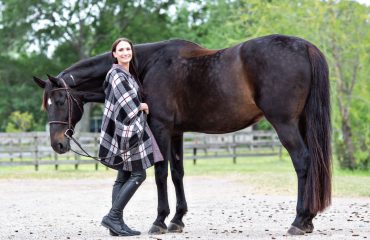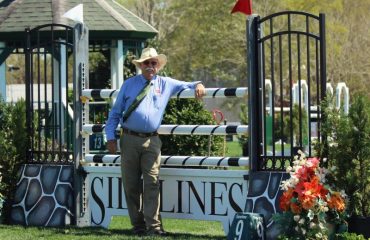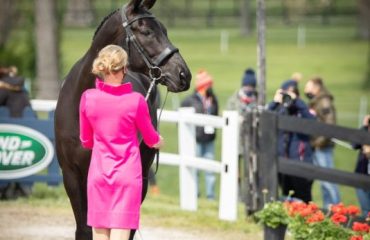By Katie Navarra

Emily competing in a Prix St. Georges class in Parker, Colorado.
Invisible communication between horse and rider takes years of practice. It may be the most important skill all riders, and especially dressage riders, strive to master. “The communication in dressage is so subtle it feels psychic or ethereal,” said Emily Keene, a Santa Fe, New Mexico, dressage trainer.
It takes introspection, years of training and persistence to learn. Without a doubt, it takes hours of practice in the saddle and Emily has found that tango dance and Bikram Yoga, two activities that require similar skills, help her in and out of the saddle. “Both dressage and tango are about subtle communication that’s mystical when you get good,” she noted.
Inconspicuous communication isn’t the only similarity between the equestrian discipline and the sensuous Argentine dance. “It’s also fun to note the similarity in footwear. Expensive, beautiful and torturous to break in,” she laughed.
Yoga, too, is like dressage, only without the partner element. “Yoga takes determination, persistence, patience and focus. You have to work on where you are, not where you wish you were,” she said.
She’s learned it’s important to have interests other than horses.
“I want to love this for the rest of my life so I have to give myself personal time. It prevents burnout and makes me better at what I do,” she said.

Emily has found that dancing the tango has many similarities to dressage.
Lifelong Love Affair
Before Emily was 5 years old, she was enamored with horses. “My favorite pastime was making believe I was a trainer. I had a stable full of imaginary horses that I rode and worked with,” she said.
Her parents enrolled her in riding lessons at the ATA Riding School in Draper, Utah. Within the first two months, she started working at the barn. “I stayed on at that barn for many years, and started teaching and training there,” she reminisced.
As a teenager, Emily led trail rides for the stable, which is located at the base of the Wasatch Mountains. “I learned so much about how to keep people safe and manage herd dynamics. You don’t have a lot of control when you’re a guide, but you have to keep everyone safe and hopefully they’re having fun as well,” she said.
Leading a group of riders up into the mountains, Emily quickly learned to match the right person with the right horse. She experienced how quickly things can go wrong and developed an appreciation for preventive action and minimizing risk.
“I learned so much about how truly valuable horses are in the human experience while guiding and teaching people from many walks of life using the most generous horses. I didn’t learn to show until I was in my 20s, but I gained something in those early years that was far more precious,” she said.
Not only did she become a skilled instructor, she discovered an intuition for understanding each horse’s personality and finding what it takes to help each horse achieve his fullest potential. She appreciates the ability within each horse, even those not necessarily bred for dressage.
With patience, she’s been able to train the most unlikely candidates for the discipline, including Domino, a Thoroughbred/Tennessee Walking Horse cross who spent much of his life on a ranch in Montana and was used in a few beginner lessons. He came to Emily when he was 21 years old. “When he came to me, he really couldn’t walk, trot or canter because he didn’t have a real trot,” she explained.
Instead of holding a true trot, he would fall out of the gait into a lateral “walk.” Aside from needing some training, he also needed some TLC. “His feet were super long, he was totally swaybacked and ewe-necked,” she said.
Starting slowly, Emily began a training and conditioning program that allowed him to stay in training until he was 25. Within those few years, the pair was schooling 4th Level movements. “I’m most proud of him because he’s not a poster child for dressage,” she said.
At 25, he was given a two-year break. When Emily rode him again at 27, he was eager to get back to work. “He was glowing with happiness and pride to have me back,” she said.

Emily Keene and Duke
Dressage, Discipline of Choice
Over the past 28 years, Emily has taught western, jumping and dressage. She’s had an opportunity to participate in competitive trail riding, endurance racing and hunter events. Through her experiences in diverse disciplines, she’s found an appreciation for the specific skills needed to succeed. But dressage has long been her favorite discipline.
“I love the lines of dressage — the grace, the power. I love the poetic aspect of it, the roundness, suppleness. I love that horses love it; it’s so touching when a horse starts to try so hard, because they love it too,” she said.
Not only is dressage beautiful to ride and watch, she believes it’s a discipline that makes horses feel good. “I think they enjoy the gymnastic and restorative nature of dressage. I find that they get a lot of personal empowerment and joy from it,” she said.
Her dressage career has spanned 21 years. During that time, she’s found success in the competitive arena with the riders she’s coached and the horses she’s trained. She schools all the Grand Prix movements and has shown to PSG (recognized) and I-1 (schooling).
She’s earned her USDF bronze and silver medals and the USDF Horse of the Year, 4th Level aboard Index, a Trakehner gelding.
She’s also collected multiple regional and state championships and reserve championships across New Mexico. Currently, she’s focused on adding a USDF gold medal to her list of accomplishments.
In addition to her competitive accomplishments, she takes pride in watching her students evolve from beginners to well-polished equestrians.
“I’m proud to take riders through the progression from very specific, overt body changes like put your leg here, through to when the conversation starts to sound more like instructions for the horse: ask him to come more up, or bend right and then finally to instructions that border on esoteric: hold the space for him and let him do it or tell him he has room within the aids,” she said.
Taken out of context, those instructions don’t mean much, but when there is a deep enough foundation, they make perfect sense.
“I get such a thrill from that level of communication, when I feel the rider get it and see the horse get it … it’s such a magical experience,” she concluded.
Visit www.keenedressage.com.
About the writer: Katie Navarra has worked as a freelance writer since 2001. She’s been a lifelong horse lover and competes in ranch horse events with her dun Quarter Horse mare.
Photos courtesy of Emily Keene












